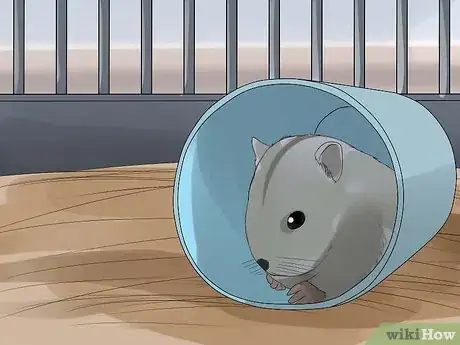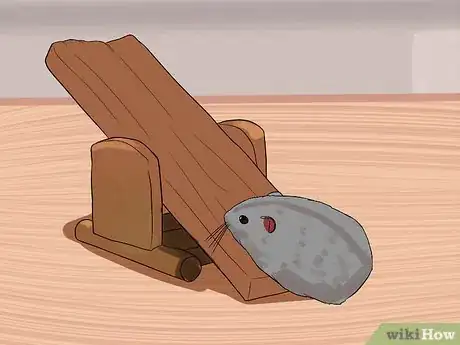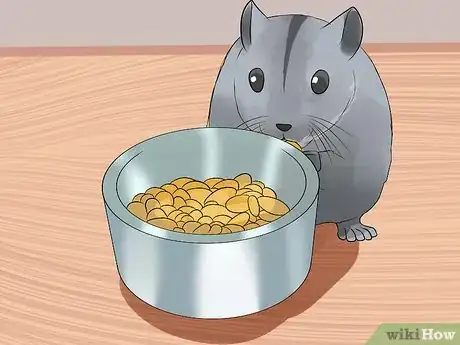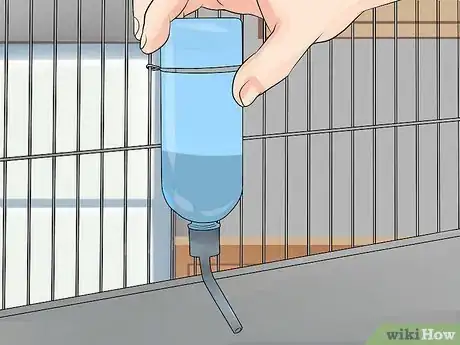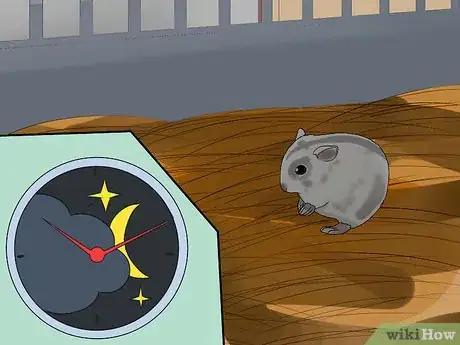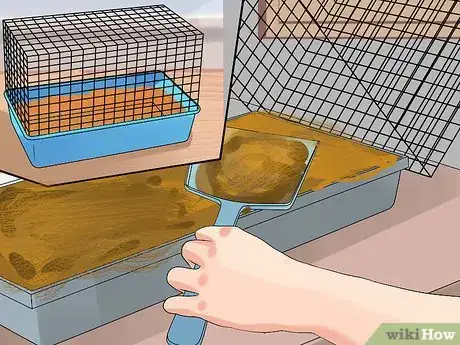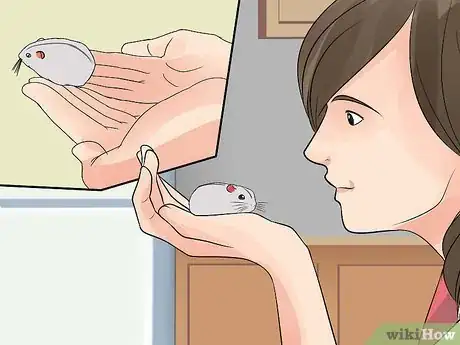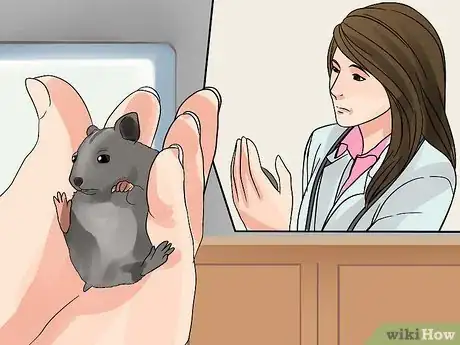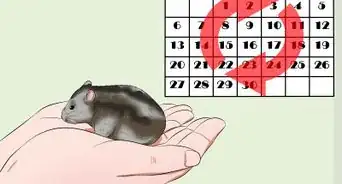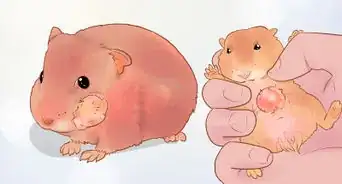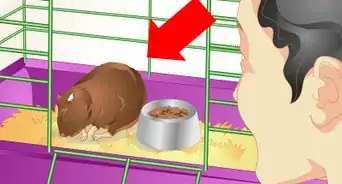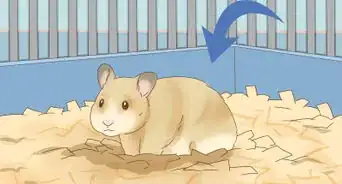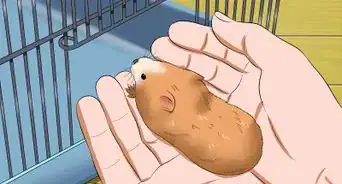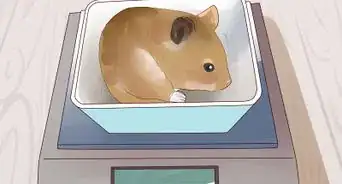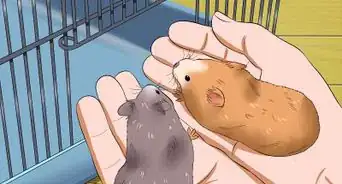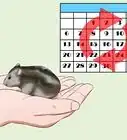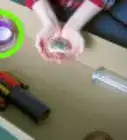This article was co-authored by Pippa Elliott, MRCVS. Dr. Elliott, BVMS, MRCVS is a veterinarian with over 30 years of experience in veterinary surgery and companion animal practice. She graduated from the University of Glasgow in 1987 with a degree in veterinary medicine and surgery. She has worked at the same animal clinic in her hometown for over 20 years.
wikiHow marks an article as reader-approved once it receives enough positive feedback. In this case, 95% of readers who voted found the article helpful, earning it our reader-approved status.
This article has been viewed 140,854 times.
Chinese dwarf hamsters are small nocturnal rodents that are about 4 inches in length when they are full grown. With their short coats and somewhat longer tails, Chinese dwarf hamsters tend to resemble a mouse or rat more than other hamsters. If you have a pet hamster or if you are considering getting one, you will want to learn all about their needs in order to provide them with proper care. Like all creatures, Chinese dwarf hamsters need a clean place to live, nutritious food, clean water, toys, affection, and regular veterinary care. Keep reading to learn more about how to care for your Chinese dwarf hamster.
Steps
Providing a Happy Home for Your Hamsters
-
1Don't get two same sex hamsters. Chinese hamsters are a solitary species and should never be housed together. Housing them together causes extreme stress and they could even kill each other.
-
2Keep your hamster in a cage made for hamster or mice. Choose a cage that is a minimum of 450 square inches or more. Line the cage with plenty of bedding such as aspen shavings or shredded paper based bedding like carefresh. Place the cage or tank out of direct sunlight and away from drafts. You don’t want your hamsters to get too hot or too cold.
- Do not use pine or cedar shavings because the fumes may be harmful to your hamsters. Scented bedding is also very harmful.[1]
- Make sure that your hamster has plenty of bedding to dig around in. Hamsters like to burrow. Provide at least six inches.
Advertisement -
3Provide your hamsters with accessories that will make them happy. For example, your hamster will enjoy an exercise wheel. Hamsters need lots of exercise to be happy, and an exercise wheel is a great way to provide them with that. Make sure that the wheel does not have any openings that may cause your hamster’s tail to get caught.
- Give your hamster a nice enclosed place to sleep. Hamsters like to hide and sleep in tight, dark spaces, so place a small flower pot or a box in your hamster’s cage.
- Add pvc tubes to your hamster’s cage for tunneling and playing. [2]
-
4Provide toys for your hamster. Hamsters like to burrow and tunnel, so cardboard tubes from toilet paper or paper towel rolls are good toys for hamsters. You can also look for special hamster toys in pets stores. You can also feed your hamster’s need to shred things by giving them paper towels and napkins now and then.[3]
- Rotate toys each week so that your hamster always has different things to play with. This will help prevent your hamster from getting bored.
Feeding Your Hamster
-
1Feed your hamster a special hamster food mix. Look for a specially formulated hamster food mix at your local pet store. Follow the package instructions for how much to give your hamster each day and serve the food in a small ceramic dish placed inside of his cage.[4]
- Limit seeds and nuts since they are high in fat and may cause your hamster to become overweight.
- Supplement your hamster’s diet with alfalfa pellets and fresh fruits and vegetables such as spinach, lettuce, carrots and apples.
- Give your hamster a large chunk to chew on rather than several small ones, or your hamster may bury them in the bedding. Remove any uneaten food after your hamster has finished with it.
-
2Provide a water bottle for your hamster. Hamsters need to have access to clean fresh water at all times. Use an inverted water bottle with a drinking tube to provide your hamsters with plenty of water. Make sure that the water bottle’s tip does not touch or come too close to the bedding or the water may drain out.
- Check the water bottle’s tip daily to make sure that it is working properly.[5]
-
3Give your hamster something to chew on. Like all rodents, a hamster’s teeth never stop growing. Hamsters need to chew to keep their teeth from growing out of control, so make sure that you provide your hamster with a stick that is safe to chew on. You can also use a dog treat.[6]
Caring for Your Hamster
-
1Remember that hamsters are nocturnal animals. Hamsters like to be awake at night, so the best time to spend time with your hamster is after the sun has gone down. For this reason, hamsters make great pets for night owls. Be aware that if you try to pick up your hamster during the day, it will be more likely to bite you.
-
2Clean your hamster’s cage regularly. To help keep your hamster happy and healthy, you will need to keep his cage nice and clean. Once per week you should also perform a deep cleaning on your hamster’s cage. Remove everything from your hamster’s cage (including your hamster) and scrub the sides and bottom with warm, soapy water. Then rinse and dry the cage before putting in new bedding, your hamster’s accessories, and your hamster. In addition to a weekly deep clean, you should also do the following every day:
- Remove and replace any soiled or damp bedding.
- Remove and dispose of droppings.
- Check the corners of your hamster’s cage for hidden food. Hamsters have a tendency to stash food for later.[7]
-
3Handle your hamster with care. It will take some time and patience before your hamster is ready to let you hold him. Build up his trust in you by allowing him to sniff your hand and even give you a little nibble. You can also offer your hamster a treat from your hand to build up his trust in you. Once your hamster is comfortable with you, you can try to pick him up.
- To pick up your hamster, gently cup both hands around him and lift him slowly out of his cage. Do not swoop in and grab him or you will startle him and cause him to hide from you.
-
4Allow your hamster some supervised time outside of his cage each day. Hamsters also need time outside of their cages to be happy. Once you have established trust with your hamster, take him out of his cage once per day for a little supervised playtime outside of his cage.
- Make sure to keep him in a room where you can monitor his movement. Otherwise he might hide somewhere and make it difficult for you to find him.
- Make sure that there are no hazards in the area, such as electrical cords, that your hamster might gnaw on.[8]
-
5Get regular veterinary care for your hamster. A healthy hamster will be much happier than an unhealthy hamster. If a hamster is well cared for, it may live to be 1-2 years old. Take your hamster for regular check-ups with the veterinarian to make sure that he stays healthy and happy.
- An unhealthy hamster may have a variety of symptoms, such as dull-looking eyes, matted fur, weight loss, shaking, runny nose and diarrhea. If your hamster is sick, take him to see a veterinarian right away.
- Hamsters can catch the common cold from humans. If you are sick, avoid holding your hamster until you are well again so that you don’t make him sick.[9]
Expert Q&A
-
QuestionHow loud are hamsters at night?
 Pippa Elliott, MRCVSDr. Elliott, BVMS, MRCVS is a veterinarian with over 30 years of experience in veterinary surgery and companion animal practice. She graduated from the University of Glasgow in 1987 with a degree in veterinary medicine and surgery. She has worked at the same animal clinic in her hometown for over 20 years.
Pippa Elliott, MRCVSDr. Elliott, BVMS, MRCVS is a veterinarian with over 30 years of experience in veterinary surgery and companion animal practice. She graduated from the University of Glasgow in 1987 with a degree in veterinary medicine and surgery. She has worked at the same animal clinic in her hometown for over 20 years.
Veterinarian Hamsters themselves are generally silent creatures that don't vocalize (make audible sounds) except for a quiet chunter or the occasional squeal. However, they are active at night which can mean lots of rustling as they rearrange bedding, scrabbling toe nails as they move around the cage, and the whirring of the hamster wheel as they put fitness first. All of these noises can be quite intrusive if the hamster is kept in a bedroom.
Hamsters themselves are generally silent creatures that don't vocalize (make audible sounds) except for a quiet chunter or the occasional squeal. However, they are active at night which can mean lots of rustling as they rearrange bedding, scrabbling toe nails as they move around the cage, and the whirring of the hamster wheel as they put fitness first. All of these noises can be quite intrusive if the hamster is kept in a bedroom. -
QuestionCan I brush my hamster with a toothbrush?
 Pippa Elliott, MRCVSDr. Elliott, BVMS, MRCVS is a veterinarian with over 30 years of experience in veterinary surgery and companion animal practice. She graduated from the University of Glasgow in 1987 with a degree in veterinary medicine and surgery. She has worked at the same animal clinic in her hometown for over 20 years.
Pippa Elliott, MRCVSDr. Elliott, BVMS, MRCVS is a veterinarian with over 30 years of experience in veterinary surgery and companion animal practice. She graduated from the University of Glasgow in 1987 with a degree in veterinary medicine and surgery. She has worked at the same animal clinic in her hometown for over 20 years.
Veterinarian Yes. Obviously, make sure the hamster has their own toothbrush and don't use one that is used to brush human teeth. Other great hamster grooming tools are eyebrow combs and also an old mascara brush that has been washed and is free from mascara.
Yes. Obviously, make sure the hamster has their own toothbrush and don't use one that is used to brush human teeth. Other great hamster grooming tools are eyebrow combs and also an old mascara brush that has been washed and is free from mascara.
Warnings
- Never give any hamster cotton. It is very dangerous, as it can cause blockages if accidentally swallowed, or, become wrapped around a hamster's limbs, both of which are very fatal. Even if hamster cotton nesting material is advertised as safe, it is still very dangerous and can kill your hamster. A great alternative is shredded up toilet or tissue paper.⧼thumbs_response⧽
- Hamsters are not recommended for children under the age of six. Make sure that you supervise children around your hamster and instruct children to handle your hamster gently.[10]⧼thumbs_response⧽
- Never give your hamster raw kidney beans, onions, raw potato, rhubarb, chocolate, candy or junk food.[11]⧼thumbs_response⧽
References
- ↑ https://www.aspca.org/pet-care/small-pet-care/hamster-care
- ↑ https://www.aspca.org/pet-care/small-pet-care/hamster-care
- ↑ https://www.aspca.org/pet-care/small-pet-care/hamster-care
- ↑ https://www.aspca.org/pet-care/small-pet-care/hamster-care
- ↑ https://www.aspca.org/pet-care/small-pet-care/hamster-care
- ↑ https://www.aspca.org/pet-care/small-pet-care/hamster-care
- ↑ https://www.aspca.org/pet-care/small-pet-care/hamster-care
- ↑ https://www.aspca.org/pet-care/small-pet-care/hamster-care
- ↑ https://www.aspca.org/pet-care/small-pet-care/hamster-care
About This Article
To care for a Chinese dwarf hamster, keep it in a large cage that's lined with timothy hay, aspen shavings, or shredded paper for bedding. You should also put toys in your hamster's cage, like an exercise wheel or an empty toilet paper roll, to keep it entertained. To feed your hamster, give it hamster pellet food every day, and occasionally treat it to some alfalfa pellets, fruit, and vegetables. Also, give your hamster something to chew on so its teeth don't grow out of control. For more tips from our Veterinary co-author, like how to clean your hamster's cage, scroll down!
